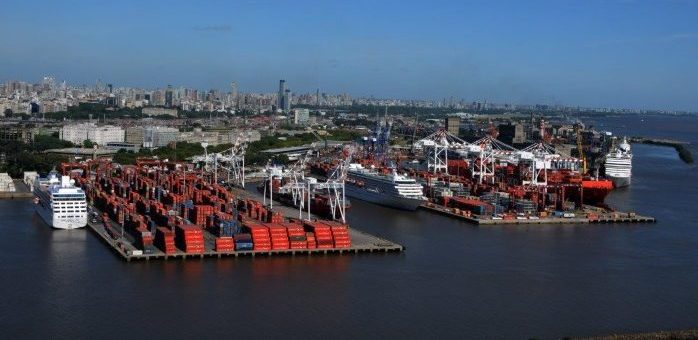Port volumes in the Buenos Aires bring upon queries regarding the policies and measures that the port adapts in order to handle numerous challenges.
A new port layout is said to make it possible to accommodate 14 000 TEU ships with a length of 365.5 metres and beam of 51.2 metres. However,
Does it make sense to build a new container port next to a metropolis and far away from the sea?
A fair question was posed by Olaf Merk – the Administrator Ports and Shipping of the International Transport Forum (ITF) – commenting on the OECD discussion paper that analyzed the key characteristics and challenges with respect to the Port of Buenos Aires.
Handling almost 90% of the Argentina’s containers, the Port of Buenos Aires is the main cargo entry point for the province.
According to the report the container ship size has quadrupled over the last two decades. The average global container ship capacity in 2016 was around 4 000 TEU, with the largest container ships able to carry 19 200 containers. The container ship size increased by the quest for economies of scale, especially on the Far East-Europe trade line where the largest ships are deployed.
However, the aforesaid deployment experiences many challenges on all maritime trade lanes due to the new larger ships:
- the ships that were used previously on Far East-Europe trade lanes will become superfluous and will be used on other trade lanes(ex. Transpacific routes)
- the ships previously used on this trade lane may then be used in other trade lanes
Subsequently, the place of Buenos Aires within the port system of the East Coast of South America is under pressure. If other ports in the regions – with deep sea access and larger terminals – would become more attractive, shipping companies might decide to cut Buenos Aires out some of their loops if they have cheaper alternatives available, e.g. in the form of hub-and-spoke networks.
The Port Authority – La Administracion General de Puertos (AGP) – plans to deepen the access channel, to change the port’s current layout consisting of finger piers into a linear quay line through land reclamation and also to move from today’s three terminals to a single one.
“It is difficult to assess how current infrastructure investments might improve the freight transport network” the paper says. “The proposal for Puerto Nuevo is framed as a solution for the long term, but it is most likely only a solution for the short, and possibly medium, term”
Policy-makers in Port of Buenos Aires are trying to find a mutually beneficial balance between port and city. Usually, ports located close to cities have difficulties expanding. That’s why several new container ports have been built further away from urban centers, and existing ports may at some point feel the need to relocate.
Mr. Olaf Merk is in favor of a long-term vision regarding the port’s future; the idea of a totally new, remote container port in a different location.
Equally Hamburg and New York are said to demonstrate that the hinterlands connections decide where to position a remote port. When considering such a strategy for a port’s future, therefore, there are many challenges that should be addressed. Building a remote port means more traffic; harder coordination of models as well as challenge for workforce to commute!






























































